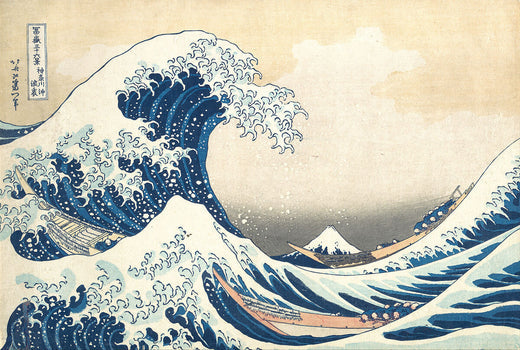
The Great Wave off Kanagawa, 1831
Katsushika Hokusai created, perhaps better known as “The Great Wave off Kanagawa, 1831”, one of the best-known and most popular pieces across Japanese art. The first impression in Katsushika Hokusai’s celebrated series of prints Thirty-Six Views of Mount Fuji, which depict the sacred mount from many different positions. The woodblock taken from the Edo Period develops a dynamic impression of nature, combining classical Japanese beauty with great innovative composition and an impressively deep narrative.
It is a staggering wave that almost looks like it will fall and give way to three small boats laboring in the wild waters off the coast of Kanagawa, the location of modern-day Tokyo. The wave was frozen at its peak and was both powerful and menacing, its foam resembling claws that could have already clawed at the fishermen below. Meanwhile, Mount Fuji stands calmly and steadfastly in the background, serenely balancing the turbulent sea.
Color is the defining element of Hokusai’s "The Great Wave off Kanagawa, 1831". The bright, engaging Prussian blue, a relatively new pigment in Japan at the time this work was done, comprises the majority of the composition. Giving the scene a remarkably alive and timeless quality is achieved by such bold use of blue combined with the detailed lines and shadings, hence an almost living quality.
The composition reveals Hokusai’s mastery of perspective, learned from both traditional Japanese art and Western techniques the latter taught him through Dutch traders. The low viewpoint and dynamic diagonal lines direct the viewer’s eye necessarily from the wave to the small figures in the boats, emphasizing human beings’ effort to combat the overwhelming power of nature. Despite the tension, the scene shows a feeling of balance and harmony typical of Japanese artistic philosophy.
Besides its aesthetic brilliance, "The Great Wave off Kanagawa, 1831" is a piece full of cultural symbolism: the great power of nature is represented through the wave, while Mount Fuji—often considered a symbol of stability and permanence—provides balance in the face of chaos. The work reflects the resiliency of humanity to the turmoil that surrounds them, as evidenced by the fishermen’s determination to navigate the sea despite daunting odds.
In fact, this print very quickly became popular in Japan and later on acquired international acclaim during the 19th century by influencing contemporary artists Vincent van Gogh and Claude Monet. Today, "The Great Wave off Kanagawa, 1831" is considered a masterpiece of ukiyo-e recording and stands as an enduring icon of Japanese art and culture.
